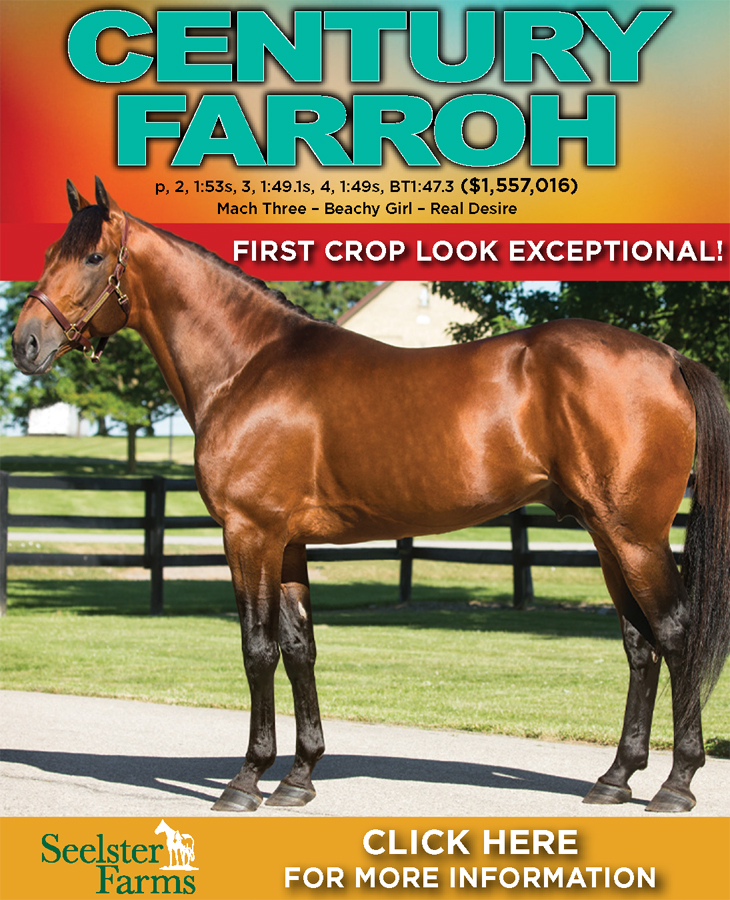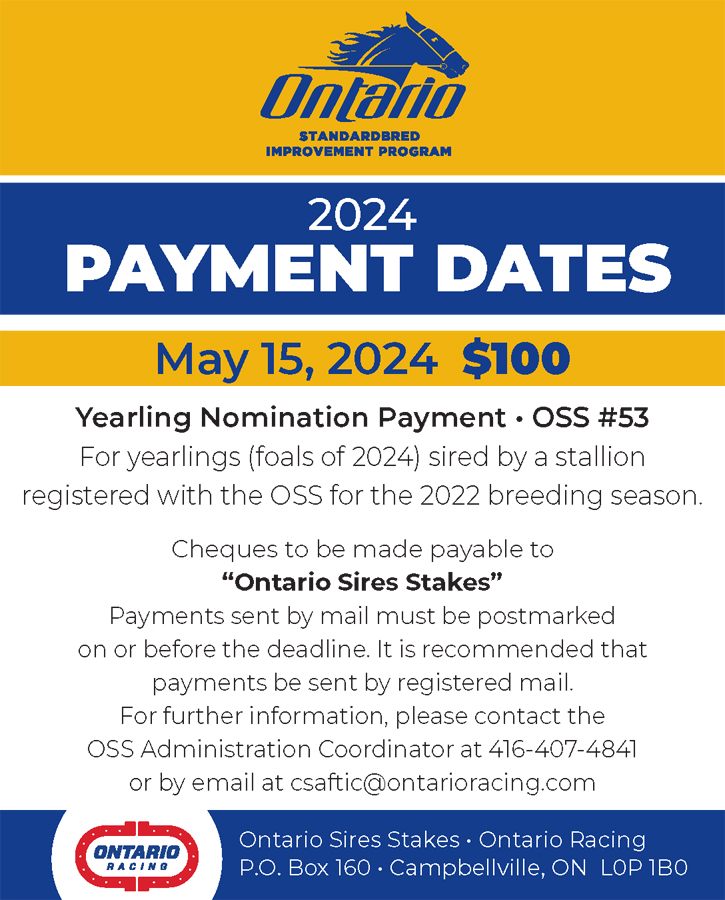

Forty years on, the success of the Breeders Crown is in its constant evolution
John Campbell and Moira Fanning explain why the series evolved as it has and even address why eliminations are absolutely necessary.
by Dave Briggs
Four decades in, one of the biggest points of pride for those that have put on the Breeders Crown is that the series has been in a constant state of evolution. From same-day heats and smaller numbers of Crown events at tracks throughout North America to today’s all-in-one format at one track per year, one could never accuse the stewards of the much-loved year-end championship series of standing pat.
“If you look at the evolution, we started out with heats and were going to different racetracks all over,” said Hambletonian Society / Breeders Crown president and CEO John Campbell. “Now, we have it at one host track every year with eliminations. There’s been a lot of fine-tuning or adjustments made throughout the years, which [former CEO] Tom [Charters] and Moira [Fanning] were a big part of those adjustments. To a certain extent, so was I because I was driving and on the Breeders Crown committee for at least 20 years.”
This weekend at Harrah’s Hoosier Park, the Breeders Crown will celebrate its 40th anniversary. Fanning, the chief operating officer of the Hambletonian Society / Breeders Crown, said this year’s event drew the most entries, the most 3-year-old colt pace entries and the richest total purse of almost $8 million. She has been involved directly with the series for 36 of its 40 years.
“The Breeders Crown, for a stake race that takes yearling payments and publishes conditions, has been incredibly receptive and flexible to the people that want to be in it, as far as the format, the locations, the time [of year],” Fanning said. “As John mentioned, imagine that we raced 2-year-olds in heats in the Breeders Crown in the early years.”
The racing schedule was also very different 40 years ago.
“If you look at the landscape of harness racing in 1984, there were many more tracks,” Fanning said. “Every track had a Grand Circuit week and their own stakes. It was a much more crowded stakes calendar. The sire stakes programs were just nascent and minimal at best, so the Grand Circuit stakes and other races of that caliber – every track had them.
“The men and women who started the Breeders Crown had to be tremendously influential to convince Edmonton, The Meadows, Pompano, Rosecroft, Garden State Park, that they had to have a Breeders Crown race.”
She said it was fortuitous that the birth of the Crown coincided with the arrival of ESPN.
“There was a national outlet for sports on TV that we had never had before,” Fanning said. “Now, most people at that time did not have cable and the idea that they didn’t know or have ESPN seems crazy now, but it’s true. Still, it carried a legitimacy to the [Crown] events and that’s why a lot of them were on Friday nights, because that’s the time that ESPN had available.”
Fanning said one of the biggest changes in the series came in 1998 when The Meadowlands asked to scrap same-day heats for the Hambletonian in favor of eliminations the week before the final.
“That was a big concession by The Society,” Fanning said. “It was a big break with tradition. They offered, as a sweetener for that, to host the Open Breeders Crowns on that same weekend, which I think still those weekends are our highest handling weekends for both events.
“Tom was able to convince Mohawk to do that as well, so that every year we switched between Mohawk and The Meadowlands with the open events and The Meadowlands would hold them on Labor Day. Now, that stretched the definition of the year-end championship, but it fit wonderfully into the calendar and fit wonderfully into the track’s schedule and it worked out – that’s how we got [Italian star] Varenne [to race in the Breeders Crown] and had a million-dollar trot. Those maybe would not have occurred in late October, but could occur in August and September.”
The modern format of having all the Crown events at the same racetrack began in 2010 at The Downs at Mohegan Pennsylvania (Pocono Downs).
In 2014, The Meadowlands asked to split up the Crown events to have the 2-year-old finals on Friday night and the 3-year-old and open finals on Saturday.
“It was logistics and also the thought that maybe we could increase handle on two nights,” Campbell said. “I remember talking to Tom Charters about it and with 12 all on one night, some of the winners would just kind of get lost in the shuffle. We found that when we did split it up four and eight, then you could focus more on the winners and they didn’t seem to get lost in the next 10 races.
“We really thought that when we did split it that it was the pattern that maybe worked the best. As of right now, we still think that.”
As the Crown is expensive to put on and not best suited to half-mile tracks, that limits the potential field of host tracks. Currently, there are three tracks in a rotation to play host to the Breeders Crown — Hoosier Park, Woodbine Mohawk Park and The Meadowlands.
“But, we are talking to another track in a totally different jurisdiction about potentially hosting in the next couple of years,” Campbell said. “We certainly will entertain any track that wants to make a presentation or an offer to host. We’re not locked into just those three tracks. We have an open mind about any track that would want to potentially host.”
ELIMINATIONS EXPLAINED
As for the modern day challenges inherent with having Crown eliminations — short fields, often uncompetitive races, fields split into less-than-desirable numbers like this year when there were six-horse races — Campbell said there are key reasons why Crown eliminations are important and a points system for which horses race in the finals would be detrimental.
“The one thing that people have to realize is that the purses are totally funded from within the industry,” he said. “And that’s the whole spectrum of the industry, from top to bottom, whether it be owners, breeders or stallion owners. The stallion owners pay their stallions in and we have from $500 stallions to $30,000 stallions that pay in and we want to keep that all-inclusive. The same with yearlings… we have yearlings from every spectrum that pay into the Breeders Crown and, again, we want to encourage that. We’re promoting hopes and dreams and the end of that dream is the potential for a Breeders Crown victory.
“In order for us to pay the purses — and, as Moira said, we’re just under $8 million this year between eliminations and finals — we’ve been able to bump our purses up the last few years and it’s because of the support within the industry and we don’t want to do anything to jeopardize that. So, a points system at the end of the year? We’d be racing for a fraction that we race for right now, there’s no doubt in my mind. So, the funding part is huge and keeping it inclusive for all of the industry is very important. Once you do that, then we have to have eliminations.
“We have to satisfy a number of entities in here. We have to satisfy the people that are paying in and make sure they all have a chance. One of the things that we’ve done is that there will be no trailers in elimination races. There will be in the finals, but not elimination races. Then, when you go from track to track, the number that they split at is different at The Meadowlands than here at Hoosier or at Mohawk. Those splits are different and the host tracks are certainly involved in that decision.
“We realize the elimination races… will not be as competitive as the finals. It’s just the way it is and it’s the same in any race that has eliminations. It’s the difference between regular season hockey and playoff hockey.
“We’re trying to satisfy more than one entity in getting the best horses with the best opportunity into the Finals.”
That said, Campbell said even the handle on this year’s three elimination nights was decent.
“For the Thursday night eliminations they bet double what they did the Thursday before at Hoosier,” Campbell said. “On the Friday night, we were up over 25 per cent from the Friday of the 2020 eliminations. Same thing on the Saturday, we were up significantly in handle at Hoosier. So, the data supports that we know they are elimination races — it says so right at the top of the page — but there’s certainly still a segment of the betting public that will still bet on them.”
As for the decision to have Crown races right to the end of the card, making for a long night, Campbell said, “it’s mostly a host track decision. They determine when they feel that they can maximize dollars with handle, so we pretty well leave it up to the host tracks. We’ll have suggestions, but the ultimate decision comes from the host track for when they want to put those races on so they can maximize handle dollars.
Fanning added, “As handle has shifted to almost all off-track and not on-track, racetracks have to, with almost surgical precision, find the window and find the time that maximizes their handle.”
As for what the next 10 years leading up to the Breeders Crown’s 50th anniversary holds, Campbell was cautious.
“I think, to be perfectly blunt and honest, I believe if the racing jurisdictions that have casino money or appropriation from their state or province’s government… as long as we can hang onto that money and that money continues for the next 10 years, I think the Breeders Crown will flourish,” Campbell said. “I don’t see a big change in how it’s presented in the next 10 years, but it’s all predicated on us holding onto that money and keep the breeding business thriving, the yearling market thriving… those are the things that are key in the Breeders Crown moving forward.”
Looking back one final time, Fanning said she gives Charters, “a lot of credit for pivoting at key moments and keeping the races going” by not being stubborn about tradition.
“Forty years to keep something going in harness racing and not just last… but [flourish] by whatever analytic you want to use, you have to call that a success,” she said.
















